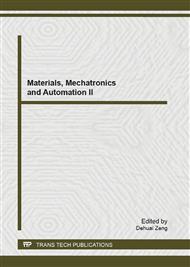p.570
p.574
p.581
p.586
p.591
p.597
p.603
p.608
p.612
Steel Microscopic Image Preprocessing and its Grain Features Extraction
Abstract:
The extraction of grains geometrical features in steel microscopic image is the important basis of metallographical analysis. In order to analyze the geometrical features automatically, firstly, we applied the double-threshold binarization and morphological transform to segment the grains and their boundaries from the gray images. Then, we presented a grain boundary tracking algorithm to separate each grain from others. Finally, we gave the definitions of grains various geometrical features (such as its size, average area, average diameter, uniformity degree and lubricity degree etc.) and their estimation methods. The experimental result shows that the given image processing method can extract grains and their boundaries efficiently. The proposed measurement methods of grains geometrical features in steel microscopic image are very helpful for more deep analysis such as the grain level evaluation, mechanical property analyzing and so on.
Info:
Periodical:
Pages:
591-596
Citation:
Online since:
August 2013
Authors:
Price:
Сopyright:
© 2013 Trans Tech Publications Ltd. All Rights Reserved
Share:
Citation:


